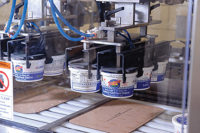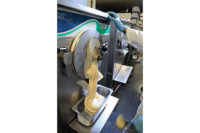Aseptic filling
Gina Dezzani is the aseptic plant manager. She, Hardy and six co-workers learned aseptic filling from their colleagues in Winchester. Then they spent two weeks in Japan at the equipment maker’s factory to get checked out on the process. The filler was disassembled, shipped to California and re-assembled in Sacramento in a room formerly used for case packing. From inception to completion, the process took about 18 months.
The aseptic line runs for 24 hours a day for six days, then it is shut down for cleaning and sterilizing, which takes 12 hours. The line mirrors the Winchester, Va., installation (see Dairy Foods, January 2005.)
“The good news was that after the installation in Winchester, we had three years to learn how to operate it,” said Hood chairman John A. Kaneb. “The bad news was that we had this time because the line was underutilized then. We learned a different task, how to operate an aseptic process and packaging line very well.”
Pallets containing 6,400 bottles each are staged on the ground floor and are automatically de-palletized. An elevator moves the bottles to the second floor where they are unbundled, placed on a conveyor belt and oriented into a single file. Then an “air-veyor” moves them around the perimeter of the room to the filler, which is located on a mezzanine level.
Milk is pumped from batch tanks to the aseptic room. The high-speed aseptic rotary filler operation includes bottle sterilization, filling and capping. From the filler, the bottles are conveyed to the ground floor where they go in turn through a sleever, a heat shrinker (to fit the sleeve/label), a case packer, a palletizer and finally to a separate warehouse that stores aseptic products. The 86,000-square-foot warehouse has 6,000 pallet positions. The products are distributed to the western United States and internationally.
















